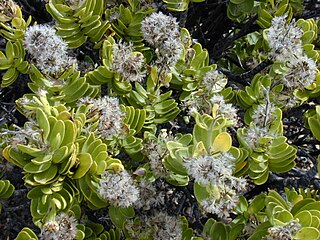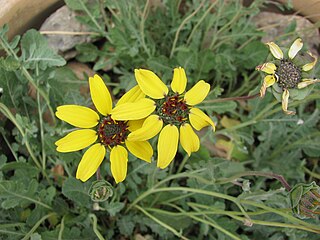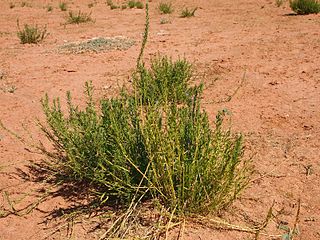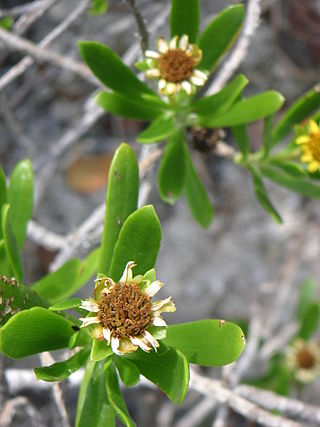
Nama is a genus of herbaceous plants belonging to the family Boraginaceae. Most are found in North America. Many are known by the common name fiddleleaf.

Custard apple is a common name for several fruits and may refer to Annonaceae, the custard apple family, which includes the following species referred to as custard apples:

Thespesia is a genus of 13 flowering shrubs and trees in the Hibiscus family, Malvaceae, although within the family they are more closely related to cotton plants (Gossypium). The genus is distributed from the South Pacific through Asia, Africa, and the Caribbean.

Morinda is a genus of flowering plants in the madder family, Rubiaceae. The generic name is derived from the Latin words morus "mulberry", from the appearance of the fruits, and indica, meaning "of India".

Parkinsonia, also Cercidium, is a genus of flowering plants in the pea family, Fabaceae. It contains about 12 species that are native to semi-desert regions of Africa and the Americas. The name of the genus honors English apothecary and botanist John Parkinson (1567–1650).

Gouania is a genus of flowering plants in the family Rhamnaceae. The 50 to 70 species it contains are native to tropical and subtropical regions of the world, including Africa, Madagascar, the Indian Ocean islands, southern Asia, the Americas and Hawaii. They are shrubs or lianas. A revision of the species in Madagascar and the other western Indian Ocean islands is in preparation, where the genus has an important centre of diversity. The work will recognise several new species.

Cenchrus is a widespread genus of plants in the grass family. Its species are native to many countries in Asia, Africa, Australia, the Americas, and various oceanic islands.

Colubrina is a genus of about 30 species of flowering plants in the family Rhamnaceae, native to warm temperate to tropical regions of Africa, the Americas, southern Asia, northern Australia, and the Indian Ocean islands.

Tecoma stans is a species of flowering perennial shrub in the trumpet vine family, Bignoniaceae, that is native to the Americas. Common names include yellow trumpetbush, yellow bells, yellow elder, ginger Thomas. Tecoma stans is the official flower of the United States Virgin Islands and the floral emblem of The Bahamas.

Dubautia is a genus of flowering plant in the family Asteraceae. The genus was named after Joseph Eugène DuBaut (1796-1832), an officer in the French Navy who participated in Freycinet's expedition.

Forestiera is a genus of flowering plants in the olive family, Oleaceae. Members of the genus are often called swampprivets. Most are shrubs.

Tiquilia is a genus of flowering plants in the borage family, Boraginaceae. The 27 species in this genus are known by the common name crinklemat. They are native to the Western Hemisphere and are mostly found in desert regions.

Berlandiera is a genus of flowering plants in the family Asteraceae.

Stemodia is a genus of flowering plants in the family Plantaginaceae. The genus comprises approximately 40 species of annual and perennial herbs and shrubs which are distributed throughout temperate and tropical regions of Asia, Africa, Australia and the Americas. This genus is sometimes placed in the families Scrophulariaceae or Gratiolaceae. The generic name is derived from the Latin word stemodiacra, which means "stamens with two tips." Twintip is a common name for several species.

Sideroxylon celastrinum is a species of flowering plant in the family Sapotaceae, that is native to Texas and Florida in the United States south through Central America to northern Venezuela and Colombia in South America. Common names include saffron plum and coma. It is a spiny shrub or small tree that reaches a height of 2–9 m (6.6–29.5 ft). The dark green leaves are alternate or fascicled at the nodes and oblanceolate to obovate. Greenish-white flowers are present from May to November and are followed by single-seeded, blue-black drupes.

Chasmanthium is a genus of North American plants in the grass family.

Lipochaeta, common name nehe, is a genus of flowering plants in the family Asteraceae that is endemic to Hawaii.

Borrichia is a genus of flowering plants in the family Asteraceae. It is named for Danish physician Ole Borch (1628–1690). Members of the genus are commonly known as seaside tansies. They are native to North and South America.

Poliomintha is a genus of flowering plants in the mint family, Lamiaceae. It is native to the southwestern United States, Haiti, and northern Mexico.























